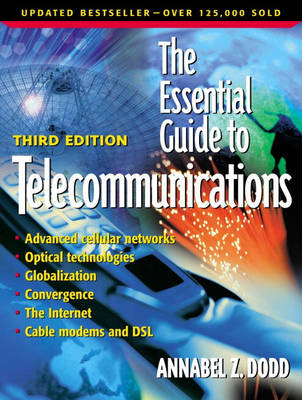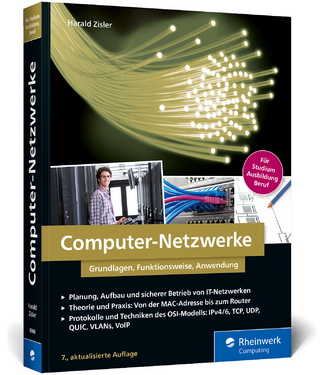
The Essential Guide to Telecommunications
Prentice Hall (Verlag)
978-0-13-064907-2 (ISBN)
- Titel erscheint in neuer Auflage
- Artikel merken
For courses in Financial Analysis and Telecommunications.
The Essential Guide to Telecommunications, Third Edition is a non-technical guide to telecommunications around the world. The text provides comprehensive discussions of globalization, optical networking technologies, convergence, speech recognition and 3G cellular networks.
ANNABEL Z. DODD is an adjunct professor at Northeastern University and has taught at the State University of New York at Stony Brook. Formerly in marketing at New England Telephone and Telecommunications and manager at a Fortune 500 company, she consults widely and gives seminars at major corporations and institutions worldwide. The Massachusetts Telecommunications Council honored her as the Professor of the Year 2000.
Preface.
Acknowledgments.
I. FUNDAMENTALS.
1. Basic Concepts.
Analog and Digital. Analog Signals. Digital Signals. Bauds, Bits, Bytes and Codes-Getting Down to Basics. Overview. Baud Rate vs. Bits per Second-Electrical Signal Rates vs. Amount of Information Sent. Codes-Adding Meaning to Bits. A Byte = A Character. Bandwidth-Measuring Capacity. Narrowband vs. Wideband-Slow and Fast. Compression and Multiplexing. Compression-Manipulating Data for More Capacity. Streaming Media. Multiplexing-Let's Share. Protocols and Architectures. Architectures-A Framework for Multiple Networks to Communicate. LANs, MANs and WANs. LANs-Local Area Networks. LAN and WAN Devices. Home LANs-Sharing Printers and High-Speed Internet Access-A Lack of Technical Support. MANs-Metropolitan Area Networks. WANs-Wide Area Networks. Higher Speed Services for LAN Traffic. New Devices for Carrier and Internet Service Provider Networks.
2. Telephone Systems, Peripherals and Cabling.
Telephone Systems-PBXs, Centrex and Key Systems. What Is a PBX? PBX Trunks. Demarcation-The Location Where Telcos Wire Trunks. PBX Telephones. Centrex-Telephone Company Supplied Service. Key Systems. Wireless PBX and Key System Telephones-On-Site Mobility. Direct-Inward Dialing-Bypassing the Operator for Incoming Calls. Convergence and Telephone Systems. Add-on Peripherals for Key Systems, PBXs and Centrex Systems. Call Accounting-Tracking Calls and Usage. ACDs-Specialized Equipment to Handle Large Volumes of Calls. Network-Based ACD Functions. LAN/PBX/ACD Connectivity to Enhance Productivity. Customer Relationship Management (CRM) for Call Centers. Integrated Voice Response Units-Using the Telephone as a Computer Terminal. Computer Telephony Integration (CTI)-Routing Callers More Intelligently. Media: Wireless, Fiber and Unshielded Twisted Pair Copper. Wireless LANs. Electrical Properties of Copper Cabling. Fiber Optic Cabling-High Capacity and High Costs.
II. INDUSTRY OVERVIEW.
3. The Bell System and Regulatory Affairs.
The Bell System Prior to and after 1984. Divestiture of the Bell System from AT&T in 1984. Regional Bell Operating Companies (RBOCs) after 1996. Transporting Calls Between Carriers. Local Competition Prior to the Telecommunications Act of 1996. Uneven Competition for Local Telephone Service Throughout the U.S. Competitive Access Providers (CAPs) to Competitive Local Exchange Carriers (CLECs). The Evolving View of the Feasibility of Local Competition. Factors Leading to Passage of the Telecommunications Act of 1996. Regional Bell Companies' Desire to Expand Their Offerings. Interexchange Carriers', Utility and Cable TV Companies' Desires to Enter New Markets. Demand for High-Speed Telecommunications Services. Technological Capabilities to Provide High-Speed Services at Low Costs. The Viability of Wireless Services for Local Exchange Service. The Desire for a Uniform National Policy on Local Competition. The Telecommunications Act of 1996. Major Features of the Act. Post Telecommunications Act of 1996 Developments. FCC Rulings, Legal Challenges and Progress Toward Deregulation. Permission for RBOCs to Sell In-Region Long Distance. Unbundled Network Elements (UNEs)-Competitors Leasing Parts of RBOCs' Networks. Fines Levied on Incumbents for Failure to Provide Timely Access to Competitors. Reciprocal Payments. Local Access Fees-A Shift in Balance Between Local and Long Distance Costs. Local Number Portability. Creating an Equal Playing Field and Conserving Numbers. Four Types of Telephone Number Portability. Impact of the Telecommunications Act of 1996. Appendix.
4. Network Service Providers and Local Competition.
Local Competition. Strategies for Entering the Local Calling Market-Resale, Wireless, Cable TV and Construction of Facilities. Carriers. Interexchange Carriers-IEXs. Bandwidth Trading: The Commoditization of Bandwidth. Merchants-Managing Risk for Carriers. Exchanges-A Place to Make Trades. Master Trading Agreements-Shortening the Transaction Cycle. Local Service Providers. AT&T. Competitive Local Exchange Carriers (Integrated Communications Providers). Resellers and Switchless Resellers. Building Local Exchange Carriers (BLECs). Agents. Summary.
5. The Public Network.
Switched Services-Local and Long Distance Calling. Attributes of Real-Time Switching Services. DTMF: Access to Voice Mail and Computers. Store-and-Forward Switching-Nonsimultaneous Sending and Receiving. Dedicated Services. Overview of Dedicated Services. Network Topologies-The View from the Top. Declining Sales of Private Lines. Virtual Private Networks-Connectivity for Remote Access, Intranets and Extranets. VPNs (Virtual Private Networks) for Electronic Commerce. VPNs for Intranet Service. Virtual Private Networks (VPNs) for Remote Access. Security on Virtual Private Networks. “The Last Mile” or Access Networks. End and Tandem Central Offices. Digital Loop Carrier Systems-Fiber Optics and Copper Cabling in the Last Mile. Carrier Hotels-Interconnecting Carriers and Providing Secure Space for Equipment. Optical Networking. Passive Optical Networks. Optical Add and Drop Multiplexers (OADM). Optical Cross Connects (OXC)-Optical Switches. Network Intelligence and Signaling. Overview of Signaling. Background. Common Channel Signaling, Efficiency and Redundancy. Signaling System 7-The Glue for Links Between Carriers. SS7 Components. Convergence-Technical Advances Leading to Improvements in IP Networks. Improvements in Routers. Digital Signal Processors (DSPs). Voice Compression. Higher Capacity Networks-Optical Technologies. Softswitches-Programmable Switches. The Quality of Service Issue for Voice over IP. SS7 in Packet Networks. Examples of Converged Networks. Free Calls or Low Priced Calls over the Internet. H.323-A Way to Make Telephone Calls over IP. Prepaid Calls over the Internet. Document Sharing and Click to Talk. Document Sharing. Summary.
III. ADVANCED TECHNOLOGIES, THE INTERNET AND WIRELESS.
6. Specialized Network Services.
T-1-24 Voice or Data Paths over One Telephone Circuit. Channel Banks-Connecting T-1 to Analog PBXs and Central Offices. DS-0 and DS-1-64,000 or 56,000 vs. 1,544,000 bps. Media Used for T-1 Signals. European vs. American and Japanese T-1-24 vs. 30 Channels. A Sampling of T-1 Configurations Using T-1 for Combining Voice, Fax, Video and Data. Fractional T-1-When 24 Paths Are Not Required. T-3-The Capacity of 28 T-1 Lines, 672 Channels. An Explanation of Time Division Multiplexing and Its Limitations. ISDN-Integrated Services Digital Network. Basic Rate Interface ISDN-Two Channels at 64,000 Bit per Second. Primary Rate Interface ISDN-24 Channels. Digital Subscriber Line Technology. Competitive local exchange carriers (CLECs) and DSL. Incumbent Telephone Company DSL Offerings. DSLAMs-Digital Subscriber Line Access Multiplexers. Obstacles to Digital Subscriber Line Availability-Cost, Ease of Implementation and Availability. DSL Lite-Lower Cost Service. DSL-A Technical Explanation. Frame Relay-A Shared Wide Area Network Service. Connections to Frame Relay-Frame Relay Access Devices and Access Line Speeds. Frame Relay for Transmitting Voice. Frame Relay Pricing-Ports, Circuits and Committed Information Rate. Potential Congestion on Frame Relay. Interfacing Between Carriers' Frame Relay Networks. Gigabit Ethernet-Ethernet over Fiber in Metropolitan Areas. Gigabit Ethernet Providers-OLECs. Gigabit Ethernet Through Partners. Gigabit Ethernet Availability. The Advantages of Using Ethernet. Speed Options-Bandwidth on Demand. Gigabit Ethernet Features at Lower Prices. A Sample Metropolitan Area Gigabit Ethernet Configuration. ATM-Asynchronous Transfer Mode. Fixed-Sized Cells-Less Processing. Switching in Hardware-Less Address Lookup. Asynchronous Switching-Improving Network Utilization. Bursting-Selling More Than the Total Capacity. Scalability-The Ability to Use ATM for High- and Low-Speed Applications and IP Traffic. Elements of an ATM Network. SONET-Synchronous Optical Network. SONET Rings-For Greater Reliability. Telephone Company SONET Offerings. SONET Connections to Wave Division Multiplexers. Meshed Optical Technology-Lower Costs, More Suitable for Data than SONET.
7. Analog, Cable TV and Digital Modems and Set-Top Boxes.
Transferring Data from Computers to Telephone Lines. DCE-Connections to Telephone Lines. Modems-Analog Telephone Lines for Transmitting Data from Digital Devices. Fax Modems. 56-Kbps Modems to Achieve Higher Speeds. PCMCIA Modems-Smaller Is Better. NT1S-CONNECTING DEVICES TO AN ISDN LINE. CSU/DSUs-Connecting Devices to a Digital Line. Cable Modems-Using Cable TV Facilities for Data Communications. Reverse Channels for Two-Way Data Communications. Cable Modems. Cable Modems for Business and for Remote Access. Set-Top Boxes. Interoperable Set-Top Boxes. Digital Cable TV. Appendix: Modem Standards.
8. The Internet.
The History of the Internet. Bulletin Board Systems (BBSs). Who Runs the Internet? Who Owns the Internet? Peering-A Way to Exchange Data Between Networks. Content Delivery Networks (CDNs) and Caching-Solving the Problem of Bogged-Down Web Sites. Internet Services. The World Wide Web-Linking and Graphics. Hypertext Markup Language (HTML)-Formatting Web Pages. Home Pages. Hosting-Computers Connected to the Internet with Home Pages. Browsers-Moving from Web Site to Web Site. Email-Computers that Send, Store and Receive Messages. Email Attachments-To Aid Collaborative Projects. HTML Email as a Marketing Tool. Instant Messaging-Real-Time Text Chats. Internet Service Providers, Application Service Providers and Portals. Dialup and Dedicated Internet Access. Application Service Providers (ASPs). Portals-Content as Well as Internet Access. Search Engines. Internet Addresses. Registries-Management of Entire Top-Level Domains. Registrars. Numeric IP Addresses. The Structure of Internet Addresses and Adding Capacity for More Addresses. New Generic Top-Level Domains (gTLDs). Country Code Top-Level Domain Names (ccTLDs). Electronic Commerce and Advertising on the Web. Advertising on the Web-A Source of Revenue. Online Commerce-What Is Profitable and Sells? Privacy on the World Wide Web. Opt-out vs. Opt-in-Different Approaches to Protecting Privacy. Legal Issues. Post-Napster Music Industry Online Efforts. The Digital Millennium Copyright Act (DMCA)-Royalties for Radio over the Internet. Anti-pornography Laws and Freedom of Speech. Filtering Software-Policing Corporate Browsing and Email. Open Cable-Cable Companies as Both ISPs and Network Service Providers. ISP Service for Cable TV. Open Cable Service-Trialing Connections to Other IPS. Intranets and Extranets. Intranets-Impact of Web Technology on Internal Operations. Extranets-Using Internet Technology with Customers, Partners and Vendors. Security on the World Wide Web- Establishing Trust. Public and Private Keys and Digital Certificates. Firewalls and Tunneling. Making the Internet a Trusted Place to Do Business. Conclusion.
9. Wireless Services.
Historical Background of Mobile and Cellular Services. Spectrum Allocation. Spectrum for Higher Speed 3G Services. Cellular Telephone Service-Technologies. Advanced Mobile Phone Services (AMPS). Digital-Advanced Mobile Phone Service-D-AMPS. PCS-Personal Communications Services. GSM Service. Specialized Mobile Frequencies for Voice-Nextel. Cellular Vendors. Verizon Wireless. Cingular Wireless. AT&T Wireless. GSM Providers. Sprint PCS. The Structure of Cellular Networks. The Cellular Market. Efforts to Improve Service-Antenna Improvements. Health Concerns. Safety on the Road. Privacy and Advertising Intrusions on Cellular E911. Called Party Pays-An Impediment to Cellular Usage. Limited Mobility Wireless for Local Telephone Service. Wireless Number Portability-Keeping the Same Number When Changing Carriers. Limitations of Circuit-Switched Cellular for Data Communications. CDPD-Cellular Digital Packet Data, IP Wireless. The Transition from Second to Third Generation Cellular Networks. The Transition to W-CDMA - GPRS-Data Carried as Packets in 2.5G Networks. EDGE-Enhanced Data Rates for GSM Evolution. Upgrades to W-CDMA from GSM-Costly. The Transition to cdma2000-1xRTT (First Generation cdma2000) and HDR (High Data Rate). A Comparison Between W-CDMA and cdma2000. Handsets for 3G and 2.5G Services. All-Packet Cellular Networks for Voice and Data. 4G-Futures. Mobile Internet Access, Messaging Services and Bluetooth. Mobile Commerce. Short Messaging Service (SMS). Bluetooth. The Wireless Application Protocol (WAP). i-mode Service Worldwide. Specialized Mobile Radio-Originally Voice, Later Data. Private Networks over Mobile Radio Frequencies. Specialized Mobile Radio-Packetized Data Networks for Two-Way Email and Field Services. Paging Services. Paging vs. Wireless Telephone Service. Two-Way Paging Using Narrowband PCS. Satellites. VSAT Service-Small Satellite Dishes. Vendors of LEOs. Time Division Multiple Access, GSM and Code Division Multiple Access Air Interfaces. Code Division Multiple Access. Time Division Multiple Access and GSM.
10. Globalization
The Impetus to Deregulate. Steps in Deregulation. Challenges. Trends in Global Markets. Latin America. Brazil. Mexico. Argentina. Impact of Poverty. Asia. China. Japan. The Internet. Cellular Service. Europe. The European Union. Cellular Service. Germany. The United Kingdom. France. Africa and the Middle East-Emerging Markets. Africa. The Middle East. Conclusion.
Glossary.
Bibliography.
Index.
| Erscheint lt. Verlag | 17.10.2001 |
|---|---|
| Verlagsort | Upper Saddle River |
| Sprache | englisch |
| Maße | 180 x 235 mm |
| Gewicht | 1012 g |
| Themenwelt | Mathematik / Informatik ► Informatik ► Netzwerke |
| Technik ► Nachrichtentechnik | |
| ISBN-10 | 0-13-064907-4 / 0130649074 |
| ISBN-13 | 978-0-13-064907-2 / 9780130649072 |
| Zustand | Neuware |
| Informationen gemäß Produktsicherheitsverordnung (GPSR) | |
| Haben Sie eine Frage zum Produkt? |
aus dem Bereich



